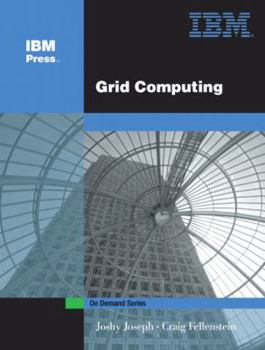Grid Computing
Teaching how to start and which applications to start with, understand the technologies and standards, and eliminate administering disparate non-integrated systems, this guide brings together... This description may be from another edition of this product.
Format:Paperback
Language:English
ISBN:0131456601
ISBN13:9780131456600
Release Date:January 2004
Publisher:IBM Press
Length:400 Pages
Weight:1.66 lbs.
Dimensions:1.1" x 7.0" x 9.2"
Customer Reviews
2 ratings
Comprehensive Description, but too Heavyweight?
Published by Thriftbooks.com User , 20 years ago
Grid computing is extensively described here as a means of providing high powered utility computing on demand. Currently, its potential is mostly unrealised. Many companies and universities have different grid implementations, as described by the authors. The universities' main motivation is to dragoon enough computing resources for hard research problems. While in the commercial sector, computer companies like IBM want to sell on demand access as a means of entering a hopefully vast new market.The grid approaches in the book collectively can be contrasted with p2p computing. Grid systems tend to use more diverse and powerful hardware and relatively small number of users. Think of this as the high end, while p2p is low end (e.g. the SETI desktop application). The book describes the vast amount of effort that has gone into devising grid standards and the various toolkits, most notably Globus. A potential problem which may occur to the reader of this book is the sheer complexity of the grid approach. Its proponents argue that this is necessary complexity. But perhaps a p2p methodology might be easier to understand and use.An analogy is with the X.400 and X.500 email and directory standards. While these are used by some companies, many have not done so. Due to the complexity and slowness. Too heavyweight. The danger for grid computing is meeting a similar fate. It may end up occupying a small high value niche, but no more.
> > > > Destined to be a classic book in its field.
Published by Thriftbooks.com User , 20 years ago
The authors have written a fine book on the potential, execution and practicality of Grid or Utility Computing. It is large ( 400 pages ) and well written book, technically accurate and blends well with other industry strategies such as on demand and Autonomic Computing. The chapters on open standards are particularly strong, well thought out and presented. The book is designed well and book production, diagrams, layout is nothing short of highest quality - in short, excellent.The prospect of true utility computing is within reach and technically feasible. The authors bring together best deployment practices, practical guidance on integrating existing resources, and applicable case studies. This book goes a long way to assisting that projection and should become a classic standard in the field.Full kudos~! - and a doff of the hat to both authors.





